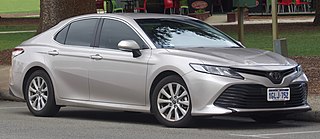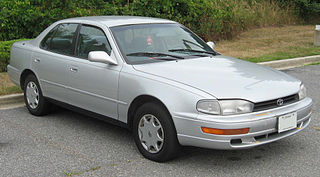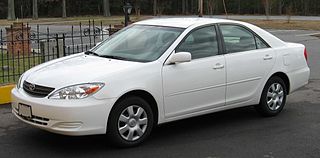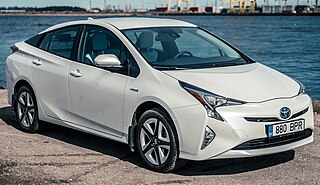
Toyota Motor Corporation is a Japanese multinational automotive manufacturer headquartered in Toyota City, Aichi, Japan. It was founded by Kiichiro Toyoda and incorporated on August 28, 1937. Toyota is the largest automobile manufacturer in the world, producing about 10 million vehicles per year.

The Toyota Avalon is a full-size sedan produced by Toyota. It is Toyota's largest front-wheel drive sedan and serves as its flagship sedan in the United States, Canada, China and the Middle East. It was also produced in Australia from April 2000 until June 2005, when it was replaced in November 2006 by the Aurion. The first production Avalon rolled off the TMMK assembly line in Georgetown, Kentucky, in September 1994, and subsequent generations have all been manufactured at the Kentucky location to date.

The Toyota Corolla is a series of compact cars manufactured and marketed globally by the Japanese automaker Toyota Motor Corporation. Introduced in 1966, the Corolla was the best-selling car worldwide by 1974 and has been one of the best-selling cars in the world since then. In 1997, the Corolla became the best-selling nameplate in the world, surpassing the Volkswagen Beetle. Toyota reached the milestone of 50 million Corollas sold over twelve generations in 2021.

The Toyota Camry is an automobile sold internationally by the Japanese auto manufacturer Toyota since 1982, spanning multiple generations. Originally compact in size (narrow-body), the Camry has grown since the 1990s to fit the mid-size classification (wide-body)—although the two widths co-existed in that decade. Since the release of the wide-bodied versions, Camry has been extolled by Toyota as the firm's second "world car" after the Corolla. As of 2022, the Camry is positioned above the Corolla and below the Avalon or Crown in several markets.

The Toyota Camry (XV10) is a mid-size car that was produced by Toyota between 1991 and 1996 in Japan and North America, and 1993 and 1997 in Australia. The XV10 series represented the third generation of the Toyota Camry in all markets outside Japan, which followed a different generational lineage. The XV10 Camry range is split into different model codes indicative of the engine. Four-cylinder models use the SXV10/SDV10 codes, with VCV10 designating the six-cylinder versions, and MCV10 the later six-cylinder cars in North America only.

The Toyota Aurion (XV40) is the original series of the Toyota Aurion, a mid-size car produced by Toyota in Australia and parts of Asia. Designated "XV40", Toyota manufactured the first generation Aurion between 2006 and 2012 until it was fully replaced by the XV50 series. While Asian production of the XV50 series began in late 2011, Toyota's Australian operations did not take on production of the new model until 2012.
United Australian Automobile Industries (UAAI) was an automobile model sharing firm that operated in Australia between 1987 and 1996 as the result of an agreement between Holden and Toyota Australia. The joint venture resulted in the two companies sharing production of locally produced automobiles by selling their models under both brands.
Toyota concept vehicles are transportation devices manufactured or designed by automobile company Toyota from 2000 to 2009. As their name suggests, these vehicles were concepts, and, as such, many were never released to dealerships. Many were developed in conjunction with other corporations such as Sony or Subaru.

The Toyota Camry (XV40) is a mid-size car produced by Toyota from January 2006 to October 2011. Replacing the XV30 series, the XV40 represented the sixth generation of the Toyota Camry in all markets outside Japan, which followed a different generational lineage. Between 2006 and 2010, a badged engineered model called Daihatsu Altis sold alongside the Camry in Japan. Toyota replaced the XV40 series in 2011 with the XV50.

A substantial car industry was created in Australia in the 20th century through the opening of Australian plants by international manufacturers. The first major carmaker was Ford Australia and the first Australian-designed mass production car was manufactured by Holden in 1948. Australian manufacture of cars rose to a maximum of almost half a million in the 1970s and still exceeded 400,000 in 2004. Australia was best known for the design and production of 'large' sized passenger vehicles. By 2009 total production had fallen to around 175,000 and the Australian market was dominated by cars imported from Asia and Europe.

The Toyota Camry (XV30) is a mid-size car produced by Toyota from June 2001 to January 2006. The XV30 series represented the fifth generation of the Toyota Camry in all markets outside Japan, which followed a different generational lineage. The XV30 range is split into different model codes indicative of the engine. Four-cylinder models utilize the ACV30 and ACV35 codes, with MCV30 (3.0-liter) and MCV31 (3.3-liter) designating the six-cylinder versions.

Manufacturing in Australia peaked in the 1960s at 25% of the country's gross domestic product, and has since dropped below 10%. At one stage manufacturing employed almost a third of Australia's workforce. Automotive manufacturing in Australia began in the 1920s and came to an end in 2017.

The Toyota Camry (XV50) is a mid-size car produced by Toyota from August 2011 to March 2019. Replacing the XV40 series, the XV50 represents the seventh generation of the Toyota Camry in all markets outside Japan, which follows a different generational lineage.

The Toyota Aurion is a mid-size car produced by Toyota in Australia and parts of Asia from 2006 to 2017. In the two generations it was produced, the Aurion was derived from the equivalent Camry. Changes were mainly limited to revised front- and rear-end treatment, along with changes to the interior. The Camry-based Aurion was also sold in the majority of East and Southeast Asia as the Toyota Camry, with the original version of the Camry sold alongside the Aurion in Australasia and the Middle East. In the previous two markets, the car replaced the Avalon model, which can trace its roots back to the early 1990s. A total of 111,140 Aurions were sold over the 10 year Australian production span.

The Toyota Mirai is a mid-size hydrogen fuel cell vehicle (FCV) manufactured by Toyota, and is the first FCV to be mass-produced and sold commercially. The Mirai was unveiled at the November 2014 Los Angeles Auto Show. As of November 2022, global sales totaled 21,475 units; the top-selling markets were the U.S. with 11,368 units, Japan with 7,435 and the rest of the world with 2,622.

The Toyota New Global Architecture are modular automobile platforms that underpin various Toyota and Lexus models starting with the fourth-generation Prius in late 2015. TNGA platforms accommodate different vehicle sizes and also front-, rear- and all-wheel drive configurations.

The adoption of plug-in electric vehicles in Australia is driven mostly by state-based electric vehicle targets and monetary incentives to support the adoption and deployment of low- or zero-emission vehicles. The monetary incentives include electric vehicle subsidies, interest-free loans, registration exemptions, stamp duty exemptions, the luxury car tax exemption and discounted parking for both private and commercial purchases. The Clean Energy Finance Corporation, energy providers, car loan providers and car insurance providers also offer their own financial incentives for electric vehicle purchases including Macquarie Bank offering the lowest electric car loan of 2.99%.

The Dynamic Force engines are a family of internal combustion engines developed by Toyota under the brand's Toyota New Global Architecture (TNGA) strategy. The engines can be fueled by petrol (gasoline) or ethanol and can be combined with electric motors in a hybrid drivetrain. The engines were developed alongside the TNGA family of vehicle platforms, as part of a company-wide effort to simplify the vehicles being produced by Toyota.
This is a list of concept vehicles made by Toyota from the years 2020–2029.


















